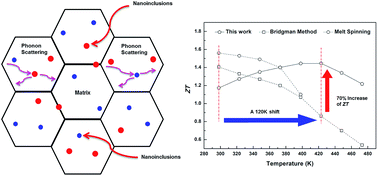A simultaneous increase in the ZT and the corresponding critical temperature of p-type Bi0.4Sb1.6Te3 by a combined strategy of dual nanoinclusions and carrier engineering†
Abstract
By means of β-Zn4Sb3 addition and thermal decomposition, dual nanoinclusions of Zn and ZnSb were introduced and Zn atoms were doped into p-type Bi0.4Sb1.6Te3 successfully. Due to the increase of hole concentration by Zn doping and band structure optimization, the bipolar conduction was suppressed and the intrinsic excitation shifts to higher temperature. The power factors of the samples were slightly improved, while the lattice thermal conductivities of the samples were greatly reduced due to the extra phonon scattering introduced by the dual nanoinclusions. As a result, the critical temperature corresponding to the maximum ZT value was greatly increased to 423 K, which is about 120 K higher when compared with the conventional Bi2Te3-based materials. A maximum ZT of 1.44 was achieved for the sample with 1.5 wt% β-Zn4Sb3 at 423 K, which is also the highest ZT value ever reported at such a high temperature for p-type Bi2Te3-based materials. This work is of importance to expand the application of Bi2Te3-based materials for low grade waste-heat recovery.


 Please wait while we load your content...
Please wait while we load your content...